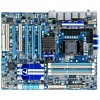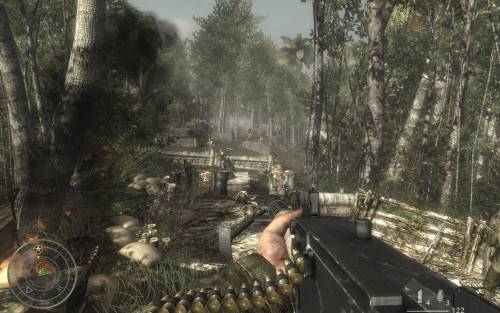- Qualcomm Launches Snapdragon 4 Gen 2 Mobile Platform
- AMD Launches Ryzen PRO 7000 Series Mobile & Desktop Platform
- Intel Launches Sleek Single-Slot Arc Pro A60 Workstation Graphics Card
- NVIDIA Announces Latest Ada Lovelace Additions: GeForce RTX 4060 Ti & RTX 4060
- Maxon Redshift With AMD Radeon GPU Rendering Support Now Available
Gigabyte’s P55A-UD7 – The Most Packed P55 Board?

Are you looking for the most feature-rich P55-based motherboard possible? With its P55A-UD7, Gigabyte looks like its up to the challenge. In addition to the usual slew of features we’ve come to expect, the UD7 includes a built-in waterblock, a Silent-Pipe add-on, 24 power phases, SATA and USB 3.0, four PCI-E 16x slots, and more.
Page 9 – Gaming: CoD: World at War, Crysis Warhead, 3DMark Vantage
While some popular game franchises are struggling to keep themselves healthy, Call of Duty doesn’t have much to worry about. This is Treyarch’s third go at a game in the series, and a first for one that’s featured on the PC. All worries leading up to this title were all for naught, though, as Treyarch delivered on all promises.
To help keep things fresh, CoD: World at War focuses on battles not exhaustively explored in previous WWII-inspired games. These include battles which take place in the Pacific region, Russia and Berlin, and variety is definitely something this game pulls off well, so it’s unlikely you’ll be off your toes until the end of the game.
For our testing, we use a level called “Relentless”, as it’s easily one of the most intensive levels in the game. It features tanks, a large forest environment and even a few explosions. This level depicts the Battle of Peleliu, where American soldiers advance to capture an airstrip from the Japanese. It’s a level that’s both exciting to play and one that can bring even high-end systems to their knees.

Crysis Warhead
As PC enthusiasts, we tend to be drawn to games that offer spectacular graphics… titles that help reaffirm your belief that shelling out lots of cash for that high-end monitor and PC was well worth it. But it’s rare when a game comes along that is so visually-demanding, it’s unable to run fully maxed out on even the highest-end systems on the market. In the case of the original Crysis, it’s easy to see that’s what Crytek was going for.
Funny enough, even though Crysis was released close to a year ago, the game today still has difficulty running at 2560×1600 with full detail settings – and that’s even with overlooking the use of anti-aliasing! Luckily, Warhead is better optimized and will run smoother on almost any GPU, despite looking just as gorgeous as its predecessor, as you can see in the screenshot below.
The game includes four basic profiles to help you adjust the settings based on how good your system is. These include Entry, Mainstream, Gamer and Enthusiast – the latter of which is for the biggest of systems out there, unless you have a sweet graphics card and are only running 1680×1050. We run our tests at the Gamer setting as it’s very demanding on any current GPU and is a proper baseline of the level of detail that hardcore gamers would demand from the game.

Futuremark 3DMark Vantage
Although we generally shun automated gaming benchmarks, we do like to run at least one to see how our GPUs scale when used in a ‘timedemo’-type scenario. Futuremark’s 3DMark Vantage is without question the best such test on the market, and it’s a joy to use, and watch. The folks at Futuremark are experts in what they do, and they really know how to push that hardware of yours to its limit.
The company first started out as MadOnion and released a GPU-benchmarking tool called XLR8R, which was soon replaced with 3DMark 99. Since that time, we’ve seen seven different versions of the software, including two major updates (3DMark 99 Max, 3DMark 2001 SE). With each new release, the graphics get better, the capabilities get better and the sudden hit of ambition to get down and dirty with overclocking comes at you fast.
Similar to a real game, 3DMark Vantage offers many configuration options, although many (including us) prefer to stick to the profiles which include Performance, High and Extreme. Depending on which one you choose, the graphic options are tweaked accordingly, as well as the resolution. As you’d expect, the better the profile, the more intensive the test.
Performance is the stock mode that most use when benchmarking, but it only uses a resolution of 1280×1024, which isn’t representative of today’s gamers. Extreme is more appropriate, as it runs at 1920×1200 and does well to push any single or multi-GPU configuration currently on the market – and will do so for some time to come.


Like the vast majority of our benchmarks throughout this review, neither motherboard totally overcomes the other in terms of performance, and gaming isn’t much different.
Support our efforts! With ad revenue at an all-time low for written websites, we're relying more than ever on reader support to help us continue putting so much effort into this type of content. You can support us by becoming a Patron, or by using our Amazon shopping affiliate links listed through our articles. Thanks for your support!








